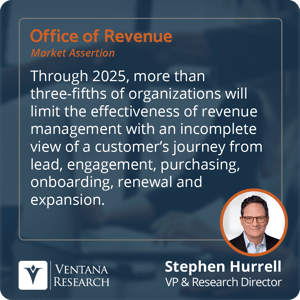Digital Transformation. The Subscription Economy. Omni-Channel Selling. Customer Centric. These are all terms used to label trends and events that are changing the way business is being conducted, a change that has accelerated due to recent events. Regardless of the terminology, there is no doubt that the way vendors and buyers are interacting, whether B2C or B2B, is different today for many organizations than it was even five years ago. But to be fair, no technology on its own can transform your business without changes to the other two key elements: people and processes. In addition, change is unlikely to happen if you are also relying on your existing ERP or CRM systems.
So why is this? Most references to business transformation include what is often called digital transformation, by which organizations are changing or adding what they sell to be, in part or in whole, as digital products or services. Buyers and customers now have the choice to engage over a variety of different channels, including digital channels, and for many, subscription and usage business models are the preferred ordering and payment methods. And this is as applicable to B2B as it is to B2C. As currently architected, most ERP and CRM systems are static, designed for products and services that infrequently change and prices that are relatively straightforward and predetermined. But the modern business model now includes dynamic pricing that can only be evaluated at either the time of consumption or at the time of billing, as it is linked to the volume and type of transactions. Likewise, for many the products and services offered are themselves frequently changing, as more organizations look to create bundles and, at the extreme, bundles for a customer segment of one.
And while there are applications and platforms available to serve those organizations that have always been predominately digital native, such as online streaming entertainment services, most organizations are still primarily transacting one-time sales. This has been extensively covered elsewhere but it is worth repeating: Many non-digitally native organizations are adopting digital selling channels, creating additional complementary digital products and services, acquiring digital products companies, and adopting subscription and usage models for existing product lines, where appropriate. For these organizations, there is a need for technology and processes that will complement existing investments, not replace them. This is where the next generation of major applications will be required.
One of the defining aspects of modern business is the need to be agile, flexible and adaptive to change. None of these are characteristics of ERP and CRM systems. In addition, the nature of the modern business is to be more knowledgeable about the customer journey from initial interest to acquisition, through adoption and leading to increased usage and repeat or expanded further purchases. Furthermore, product and service information must evolve from unidirectional product details and images that support self-service and direct sales to bidirectional to capture product usage and the customer experience. And organizations need to be able to quickly bundle and create new offerings, not just from a vendor’s own products but also from potential partners as well. Supplementing existing ERP and CRM will address these challenges as well as supporting the computational needs of calculating price and costs at run time and dynamically evaluating the impact of revenue recognition to ensure quotes and orders are complying during the sale, not after.
While some view Revenue Management as an accounting or finance-owned issue, I believe this really is a cross-functional responsibility, involving all departments that support revenue generation including sales, marketing, product, customer success and professional services as well as operations, finance, accounting and legal. But our view is that, through 2025, more than three-fifths of organizations will limit the effectiveness of revenue management with an incomplete view of a customer’s journey from lead, engagement, purchasing, onboarding, renewals and expansion. Both the CFO and CRO have a direct interest in enabling the technology to support the necessary people and process transformation needed to achieve the flexibility and agility required. This means that cross-team collaboration must be more than a slogan; rather, it needs to be part of a managed accountability linked through common goals and incentives as well as through processes, data and shared platforms and collaboration tools.
 Likewise, from a customer experience (CX) perspective, any new systems that overlay existing systems need to ensure that the customer is seeing a unified approach to not only basics, such as billing and payments, but also customer support and service. The customer should not be concerned with an organization’s internal product and line-of-business reporting if they are purchasing and engaging in a bundled set of product and device offerings. I discuss more on the importance of this seamless approach to supporting CX in my Analyst Perspective Subscription Automation Enables a Better Subscriber Experience.
Likewise, from a customer experience (CX) perspective, any new systems that overlay existing systems need to ensure that the customer is seeing a unified approach to not only basics, such as billing and payments, but also customer support and service. The customer should not be concerned with an organization’s internal product and line-of-business reporting if they are purchasing and engaging in a bundled set of product and device offerings. I discuss more on the importance of this seamless approach to supporting CX in my Analyst Perspective Subscription Automation Enables a Better Subscriber Experience.
As there are not yet fully built-out platforms to support these requirements as there are for ERP or CRM, a buying organization cannot purchase an entire platform at once but should think of individual components, such as a billing and subscription management, that can support their evolving business models while still utilizing existing bill presentment, accounts receivable and collections technology and processes. But attention should be paid as to how any product under consideration will utilize existing technology adoption within the organization that is already using an API and connector strategy. And buying organizations should avoid pursuing a “point solution” approach that temporarily addresses a single pain point but will ultimately prove hard to integrate with other parts of the overall approach.
Regards,
Stephen Hurrell

 Likewise, from a customer experience (CX) perspective, any new systems that overlay existing systems need to ensure that the customer is seeing a unified approach to not only basics, such as billing and payments, but also customer support and service. The customer should not be concerned with an organization’s internal product and line-of-business reporting if they are purchasing and engaging in a bundled set of product and device offerings. I discuss more on the importance of this seamless approach to supporting CX in my Analyst Perspective
Likewise, from a customer experience (CX) perspective, any new systems that overlay existing systems need to ensure that the customer is seeing a unified approach to not only basics, such as billing and payments, but also customer support and service. The customer should not be concerned with an organization’s internal product and line-of-business reporting if they are purchasing and engaging in a bundled set of product and device offerings. I discuss more on the importance of this seamless approach to supporting CX in my Analyst Perspective 








